Commissioned 29 June 1987 Length 83 m Endurance 3.9 months | Yard number 72 Launched 12 December 1985 Draft 6.22 m | |
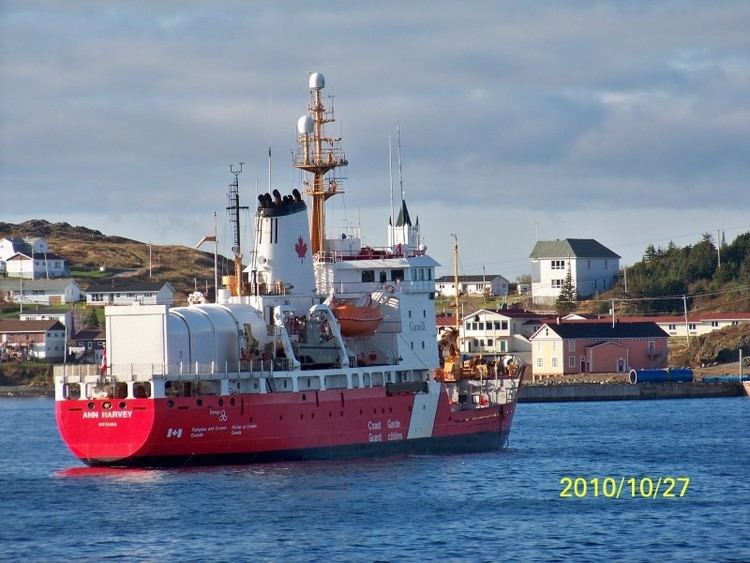 | ||
Builder Halifax Regional Municipality | ||
Ccgs ann harvey
CCGS Ann Harvey is a Canadian Coast Guard buoy tender and SAR vessel with light icebreaker duties. She was constructed in 1987 by Halifax Dartmouth Industries, in Halifax, Nova Scotia. The vessel was named after Ann Harvey, the daughter of a local Newfoundland fisherman who helped rescue 185 people during her lifetime. Ann Harvey's home port is St. John's, Newfoundland and Labrador and is stationed there with other Coast Guard ships.
Contents
- Ccgs ann harvey
- Assistance to ccgs ann harvey porter secours au ngcc ann harvey
- Design and description
- Service history
- References
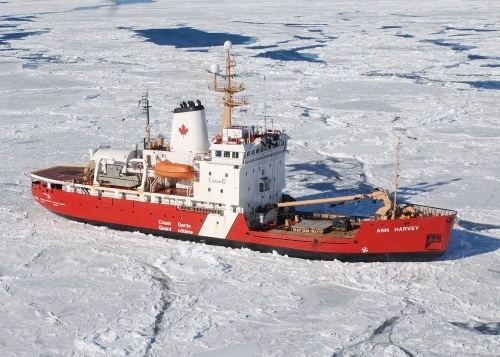
Assistance to ccgs ann harvey porter secours au ngcc ann harvey
Design and description

The final ship of the Martha L. Black class, the vessel carries a boom, skimmer and environmental response equipment. Ann Harvey displaces 4,642 long tons (4,716 t) fully loaded, has a gross tonnage (GT) of 3,823 and a net tonnage (NT) of 1,528. The ship is 83 metres (272 ft 4 in) long overall with a beam of 16.2 metres (53 ft 2 in) and a draught of 6.22 metres (20 ft 5 in).
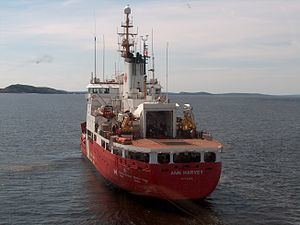
Ann Harvey is propelled by two fixed pitch propellers and bow thrusters powered by three Alco 251-16V diesel-electric engines creating 8,847 horsepower (6,597 kW) and three Canadian GE generators producing 6 megawatts of AC power driving two Canadian GE motors creating 7,040 horsepower (5,250 kW). The ship is also equipped with one Caterpillar 3306 emergency generator. This gives the ship a maximum speed of 16.5 knots (30.6 km/h; 19.0 mph). Capable of carrying 780 long tons (790 t) of diesel fuel, Ann Harvey has a maximum range of 8,200 nautical miles (15,200 km; 9,400 mi) and 6,500 nautical miles (12,000 km; 7,500 mi) at 15 knots (28 km/h; 17 mph) and can stay at sea for up to 120 days. The ship is certified as Arctic Class 2.
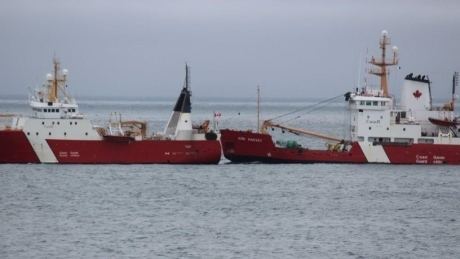
The vessel is equipped with one Racal Decca Bridgemaster navigational radar operating on the I band. Ann Harvey has a speed crane derrick capable of lifting 20 long tons (20 t) and two sea cranes capable of lifting 2.5 long tons (2.5 t). The ship carries a 6-metre (20 ft) rescue craft and a self-propelled barge. Ann Harvey is equipped with a flight deck and a hangar that can house two light helicopters of the MBB Bo 105 or Bell 206L types. However, the vessel is only allotted one helicopter. The ship has a complement of 26, with 10 officers and 16 crew. Ann Harvey has 23 additional berths.
Service history

Constructed by Halifax Dartmouth Industries at their yard in Halifax, Nova Scotia with the yard number 72, Ann Harvey was launched on 12 December 1985. The vessel entered service with the Canadian Coast Guard on 29 June 1987, registered in Ottawa, Ontario. The vessel is assigned to the Newfoundland Region, homeported at St. John's, Newfoundland and Labrador.
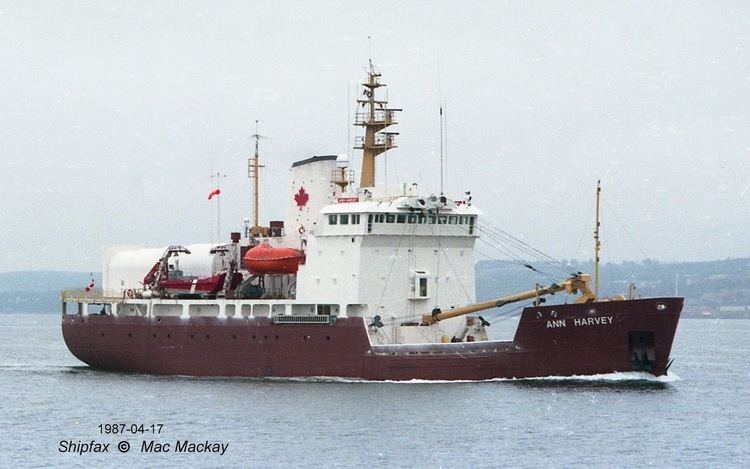
On 1 April 2015, Ann Harvey ran aground 5 nautical miles (9.3 km; 5.8 mi) southwest of Burgeo, Newfoundland and Labrador. The ship had been performing work on buoys when it hit bottom. A hole was torn in the hull and as she pulled back off the rocks, water flooded the motor propulsion room. Some personnel were evacuated and CCGS Louis S. St-Laurent was sent to tow Ann Harvey to Connoire Bay. When the ship was damaged it lost power when the motor propulsion room and the space aft of it were flooded.
The lifeboat CCGS W.G. George was the first ship to arrive on scene. W.G. George towed Ann Harvey to the west. At 1:30 a.m. Louis S. St-Laurent arrived and took over. Ann Harvey was towed to a spot west of Burgeo in Connaigre Bay, where Royal Canadian Navy divers working from HMCS Charlottetown which was dispatched from Canadian Forces Base Halifax, inspected the ship's damage. Once temporary repairs were completed, the ship was towed to St. John's where permanent hull repairs were completed at NewDock St. John's Dockyard LTD.
While undergoing repairs in St. John's, it was decided by the Canadian Coast Guard to begin the ship's Vessel Life Extension refit. The engines were removed and sent to Burlington, Ontario for overhaul. The crew lounge, engineer offices and helicopter track were cut out of the ship in order to remove the engines. The refit should last until mid-2017.
